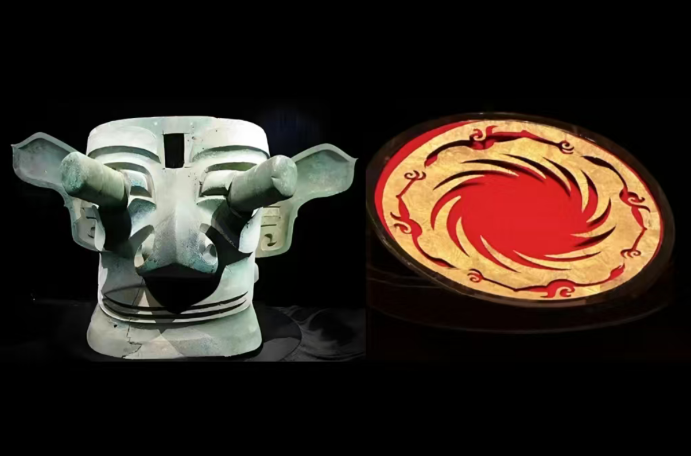
Over 3,000 years ago, a mysterious civilization thrived in Sichuan, China. Archaeologists found two amazing sites: Sanxingdui (1929) and Jinsha (2001). Their discoveries tell us about a kingdom that loved gold, art, and nature!
At Sanxingdui, people made giant bronze masks with big eyes and wild hairstyles. Hairstyles showed their jobs: those with braids managed villages, while others with jade-pinned hair led ceremonies. Later, something big happened — maybe a fight or disaster. The braided-hair group moved to Jinsha, where they created new art like the famous Golden Sun Bird.
Gold was SUPER important! Sanxingdui’s biggest gold mask (as heavy as a pineapple!) covered a bronze head, maybe for worshiping gods. Jinsha’s star treasure is a paper-thin gold foil (箔) called Sun and Divine Birds. It shows four birds flying around the sun — a symbol of their love for nature.
Both cities were smart builders. They used rivers to separate temples from homes. They even traded with faraway lands! Seashells from the Indian Ocean and elephant tusks from Southeast Asia were found there.
Today, archaeologists still dig at these sites. In 2001, they found bronze pieces at Jinsha — maybe more giant statues are hidden underground! From this year (2025), a special project will study how these ancient people lived, traded, and connected with other cultures.
Isn’t it cool? A lost kingdom’s story is being pieced together, one golden bird at a time!
原创编写 版权所有 侵权必究! 每日更新 个性化阅读 英语飙升!
1.1. What did the hairstyles of people in Sanxingdui show?
A Their ages.
B Their hobbies.
C Their jobs.
D Their wealth.
解析:选C。C 细节理解题。由第二段中的“Hairstyles showed their jobs: those with braids managed villages, while others with jade-pinned hair led ceremonies.”可知,三星堆人的发型显示了他们的工作,A. 年龄、B. 爱好、D.财富,在文中均未提及,属于无中生有。故选C。
2.2. Why might the braided-hair group move to Jinsha?
A To find more gold.
B To escape conflicts/disasters.
C To trade seashells.
D To build temples.
解析:选B。B 推理判断题。第二段提到的“something big happened — maybe a fight or disaster”导致迁移,选项B合理推断;选项A/C/D均为文中其他细节的错位组合。故选B。
3.3. What does “paper-thin” mean in describing the gold foil?
A Very heavy.
B Extremely thin.
C Covered with paper.
D Used for writing.
解析:选B。B 词义猜测题。根据上下文,金箔被形容为“Sun and Divine Birds”且需要薄如纸才能展现精细图案。选项B符合逻辑;选项C望文生义,选项A/D与文意相反。故选B。
4.4. What items show people traded with faraway lands?
A Gold masks.
B Bronze statues.
C Pineapples.
D Seashells.
解析:选D。D 细节理解题。根据第四段中的“They even traded with faraway lands! Seashells from the Indian Ocean and elephant tusks from Southeast Asia were found there.”可知,发现了来自印度洋的贝壳,这表明他们与遥远的地方进行了贸易。A选项金面具、B选项青铜雕像、C选项菠萝在关于贸易物品的描述中未提及,属于无中生有。故选D。
5.5. What is the best title for the passage?
A Ancient Sichuan Civilization.
B The Artworks in Sanxingdui.
C The Role of Rivers.
D Modern Discoveries.
解析:选A。A 主旨大意题。文章主要讲述了中国四川3000多年前神秘的文明,包括三星堆和金沙遗址的发现、人们的生活、艺术以及建筑等方面。故选A。
